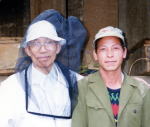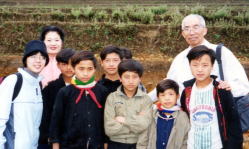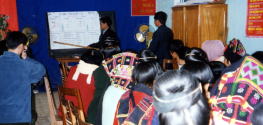No.187-3
Revisiting Sites of “Education Projects” in Vietnam 2002.4.14-20
|
|
Shigeo Tajima
Advisor, Meguro UNESCO Association
At the request o f the Japan Federation of UNESCO Associations, I visited Vietnam to observe
the progress of the Terakoya project there for one week from April 14. As
it was my second visit, I did not mind this time the long, exhausting trip
of four hours from Dien Bien Phu nor the steep winding roads. I was anxious
to see how our advice that bee raising suits the village the most had turned
out.
f the Japan Federation of UNESCO Associations, I visited Vietnam to observe
the progress of the Terakoya project there for one week from April 14. As
it was my second visit, I did not mind this time the long, exhausting trip
of four hours from Dien Bien Phu nor the steep winding roads. I was anxious
to see how our advice that bee raising suits the village the most had turned
out.
The beekeeper, who was at the top on our visiting list, was located at
the center of Xa Nhe village, 300 meters off the road. We found that he
adopted the new bee raising method which we taught, increased the bee raising
boxes from 2 to 10 and was expecting the harvest to become double what
it was. Moreover, the neighboring beekeepers hold regular meetings on the
28th day of every month to share their experiences and discuss problems
together. You can imagine how excited we were to see that our advice has
turned out quite successful.
We then visited another beekeeper's farm located in the second Xinh Su
area of the same village, where a young boy greete d us. Contrary to our expectation, his father did not show up. We were
surprised to find out that the boy answered all our questions about bee
raising without any trouble. We were doubly surprised to find out that
he, who was 13 years old, not only participated in the “classes to learn
how to write” and the “classes for bee raising” but also made use of
his own idea to install the new type of equipment in the old-fashioned
beehives. Young as he is, he has displayed ingenuity as well as readiness
to act while looking after the livelihood and the future of his large family
of eleven. Every one of us felt certain that he would become a leader for
the area in the future.
d us. Contrary to our expectation, his father did not show up. We were
surprised to find out that the boy answered all our questions about bee
raising without any trouble. We were doubly surprised to find out that
he, who was 13 years old, not only participated in the “classes to learn
how to write” and the “classes for bee raising” but also made use of
his own idea to install the new type of equipment in the old-fashioned
beehives. Young as he is, he has displayed ingenuity as well as readiness
to act while looking after the livelihood and the future of his large family
of eleven. Every one of us felt certain that he would become a leader for
the area in the future.
Next we visited a small village called Xinh Ping of the Thai tribe. On
our last visit, about 40 housewives and young women were taking the agricultural
training co urses and we were anxious to see how the courses bore fruit.
A 17-year-old girl bred earthworms to supply protein feed to chickens,
ducks and eels. An older housewife started to culture mushrooms artificially
and proudly showed us a fungus bed made of sawdust, which was already full
of mushroom shoots. Another housewife started chicken farming and took
us to see her farm.
Vietnam is still a developing country with a GNP less than 10 percent of that of
Japan. But I feel that every Vietnamese is trying hard to develop his or
her business and living. Is it too much to say that the Japanese youth,
surrounded by such a bountiful environment, is taking a nap? Even a slow
turtle can overtake a fast rabbit that is taking a nap. In fact, Singapore,
Hong Kong and the Republic of Korea overtook us in the field of IT. When
the society of Japan and the other countries of the world are faced with
serious problems, it seems that Japanese youth either consider that it
does not concern them at all or close their eyes to the problems. In contrast,
every time I visit Vietnam, I receive the opposite impression and the encouraging
message from their youth before returning to Japan.
still a developing country with a GNP less than 10 percent of that of
Japan. But I feel that every Vietnamese is trying hard to develop his or
her business and living. Is it too much to say that the Japanese youth,
surrounded by such a bountiful environment, is taking a nap? Even a slow
turtle can overtake a fast rabbit that is taking a nap. In fact, Singapore,
Hong Kong and the Republic of Korea overtook us in the field of IT. When
the society of Japan and the other countries of the world are faced with
serious problems, it seems that Japanese youth either consider that it
does not concern them at all or close their eyes to the problems. In contrast,
every time I visit Vietnam, I receive the opposite impression and the encouraging
message from their youth before returning to Japan.
Photographs:
Left above; At Mon tribe’s beekeeper’s firm (Left is Mr. Tajima)
Right; Children bearing the future
Left below;Agricultural training classes for women of Thai tribe
3